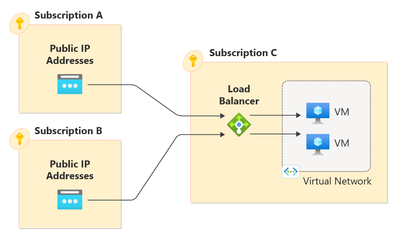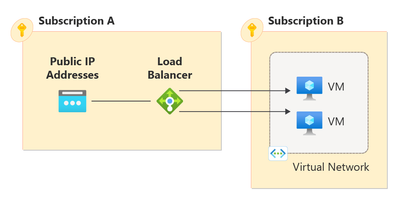[vc_row][vc_column width=”1/6″][/vc_column][vc_column width=”2/3″][vc_column_text]As businesses increasingly embrace cloud solutions, the need for flexible and scalable infrastructure becomes paramount. Azure Load Balancer, a critical component in Microsoft’s Azure ecosystem, has recently introduced a game-changing feature: cross-subscription support. In this article, we explore how this capability empowers organizations to architect robust and efficient applications across different Azure subscriptions.
What Is Cross-Subscription Load Balancing?
Traditionally, Azure Load Balancer components (such as frontend and backend instances) were confined to a single subscription. However, with the advent of cross-subscription load balancing, you can now distribute these components across multiple subscriptions. Let’s take look into these key features:
Cross-Subscription Frontends:

Public and internal frontends can now reside in different subscriptions.
Public IP addresses associated with load balancers can span various subscriptions.
For internal frontends, the configuration must align with the same virtual network (VNet) as the internal load balancer.
Cross-Subscription Backends:

Backend pools can include instances from other subscriptions.
Regional load balancers can reference VNets belonging to different subscriptions.
The new syncMode property facilitates seamless cross-subscription load balancing.
Regional and Global Load Balancers:
Regional load balancers can connect to global load balancers, even if they are in separate subscriptions.
However, cross-subscription frontends are not compatible with global load balancers.
Real-World Scenarios
Let’s explore two scenarios where Azure Load Balancer’s cross-subscription capabilities shine:
Contoso1: Financial Services Migration
Background: Contoso1, a large financial services company in Asia, is migrating its services from on-premises to Azure.
Challenge: Their primary application—a payment processing service—requires high availability and scalability.
Solution: By leveraging cross-subscription load balancing, Contoso1 can distribute frontend and backend resources efficiently. Public IP addresses, VNets, and backend VMs seamlessly collaborate within different subscriptions.
Tech Innovators: Multi-Tenant SaaS Platform
Background: Tech Innovators develops a multi-tenant SaaS platform serving diverse clients.
Challenge: Each tenant demands isolated resources while sharing common services.
Solution: With cross-subscription load balancing, Tech Innovators can allocate separate subscriptions for each tenant’s resources. The load balancer orchestrates traffic intelligently, ensuring optimal performance and security.
Bottomline
Azure Load Balancer’s cross-subscription support opens up exciting possibilities for architects, developers, and businesses. Whether you’re optimizing resource allocation, enhancing security, or scaling applications, this feature empowers you to design robust and flexible solutions.
Are you ready to harness the full potential of cross-subscription load balancing?
Scan the QR code below to Contact IK Technologies USA today to explore how our expertise can ease your Azure Cloud journey.

IK Technologies USA | Empowering Your Cloud Journey
[/vc_column_text][/vc_column][vc_column width=”1/6″][/vc_column][/vc_row]



